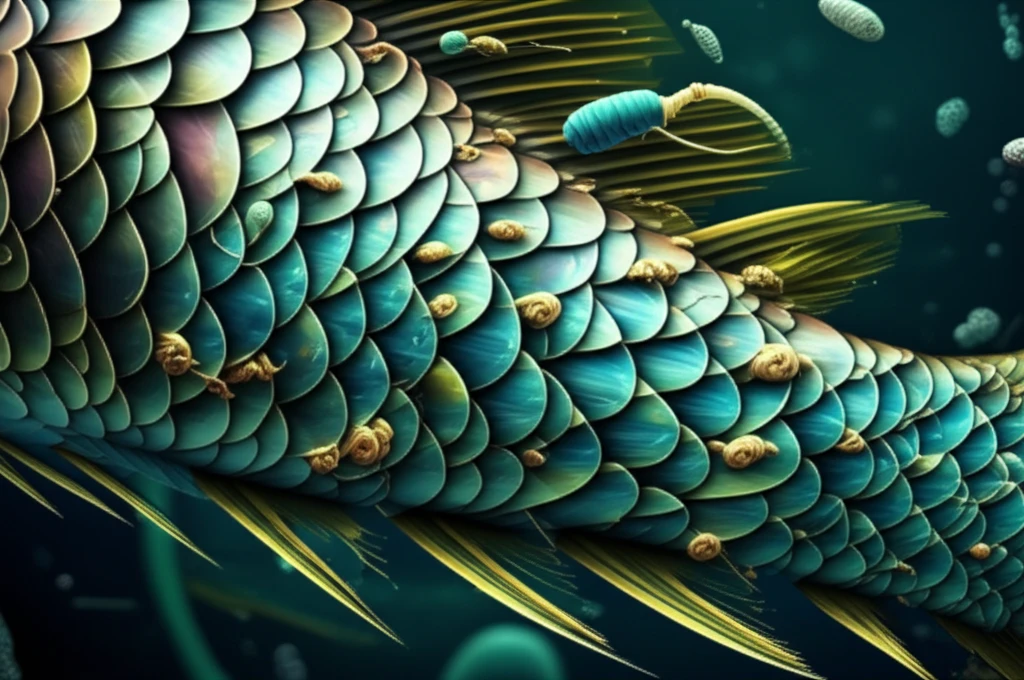
Silent Threat: How Parasites Impact Fish Health and Aquaculture
"Uncover the hidden dangers of monogenean infestations in fish farming and what it means for the future of sustainable aquaculture."
Aquaculture, the farming of aquatic organisms, faces numerous challenges, with disease being a primary concern. Parasitic infections, in particular, pose a significant threat to fish health and the overall productivity of aquaculture systems. These infections can lead to reduced growth rates, increased susceptibility to other diseases, and ultimately, economic losses for fish farmers.
One of the most common parasitic infections in fish is caused by monogeneans, a group of ectoparasites that primarily infest the gills and skin. While the impact of monogenean infestations can vary, severe infections can disrupt gill function, impair respiration, and trigger a cascade of physiological changes in the host fish. Understanding these changes is crucial for developing effective strategies to manage and mitigate the effects of parasitic infections in aquaculture.
This article delves into the specific effects of Thaparocleidus sp., a type of monogenean, on the health of Pangasianodon hypophthalmus, commonly known as Sutchi catfish or iridescent shark. By examining the haematological (blood-related) and biochemical parameters of infected fish, we can gain insights into the physiological consequences of parasitic infestations and identify potential biomarkers for assessing fish health.
Decoding the Impact: How Thaparocleidus Infestation Alters Fish Physiology

A recent study investigated the impact of varying degrees of Thaparocleidus sp. infestation on the haematological and serum biochemical parameters of Pangasianodon hypophthalmus. The study revealed significant alterations in several key indicators, providing a clearer picture of how these parasites affect fish health. Here's a breakdown of the findings:
- Increased Erythrocyte and Haemoglobin Levels: Fish with moderate to high infestations showed significant increases in total erythrocyte count (TEC) and haemoglobin (Hb) levels. This may indicate the fish's attempt to compensate for reduced oxygen uptake due to gill damage caused by the parasites.
- Changes in Blood Indices: The study also found significant decreases in mean cell volume (MCV) and mean cell haemoglobin (MCH) in moderately to highly infested fish, suggesting potential anaemia.
- Elevated Leukocyte Count: The total leucocyte count (TLC) was significantly elevated in infested fish, indicating an immune response to the parasitic infection.
- Altered Serum Enzyme Activity: The activities of serum glutamate oxaloacetate transaminase (SGOT), serum glutamate pyruvate transaminase (SGPT), and alkaline phosphatase (ALP) were significantly higher in infested fish, suggesting tissue damage and stress.
- Increased Lactate and Bilirubin: Lactate dehydrogenase (LDH) activity and lactate levels, as well as serum bilirubin and creatinine concentrations, were also elevated in infested fish, indicating metabolic disturbances and potential kidney dysfunction.
Protecting Our Fish: Towards Sustainable Aquaculture Practices
The study underscores the importance of proactive measures to control and prevent parasitic infections in aquaculture systems. Regular monitoring of fish health, appropriate stocking densities, and effective biosecurity protocols are crucial for minimizing the risk of monogenean infestations and their associated consequences.
Furthermore, the identified haematological and biochemical markers can be used to develop rapid and accurate diagnostic tests for detecting parasitic infections in fish. Early detection allows for timely intervention and prevents the spread of the disease, reducing economic losses and promoting sustainable aquaculture practices.
By understanding the intricate relationship between fish, parasites, and their environment, we can develop innovative strategies to safeguard fish health and ensure the long-term sustainability of aquaculture, providing a reliable source of protein for a growing global population.
